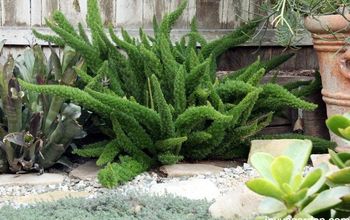How to Grow Asparagus That Tastes Better Than Store-Bought

By Sharon Brandwein
Anyone who’s ever tended their own garden will probably tell you there’s no sweeter fruits or vegetables than the ones you pluck from the vine or pull from the earth with your bare hands. Maybe it’s the absence of chemicals and pesticides, or maybe it’s the extra heaps of love and attention, but either way: homegrown veggies never seem to disappoint.
Asparagus is one of those delectable veggies. These guys may be a huge lesson in patience, but they’re always worth the wait. While they typically take a couple of seasons to yield a generous harvest, you’ll find that asparagus is the gift that keeps on giving. These perennial plants can keep producing for many years—sometimes upwards of 15-20 years.
Ahead we take a deep dive into the world of asparagus. We tackle all the details of how to grow asparagus, including whether to start from a seed or crown, choosing male versus female plants, how and when to plant asparagus, and finally, how to care for and harvest them.
Photo via Mama's Homestead
What Is the Difference Between Male and Female Asparagus?
Before we begin, it may be important to note that asparagus plants are monoecious; this means that each plant is either male or female, and that could make quite a difference in your yield. Overall, male asparagus plants tend to be more productive; they yield more harvestable shoots because they don't have to divert any energy into producing seeds. So, if you're looking for a particularly bountiful asparagus harvest year after year, you might want to stick to an all-male variety of asparagus such as Jersey Knights or Jersey Giant.
Should You Grow Asparagus from Seeds or Crowns?
Both are fine; it’s all a matter of how long you want to wait and how much patience you have.
Essentially, growing asparagus from seed just means that you’ll start with seeds planted in a plug tray, transplant them into small pots somewhere around three months, and finally transplant them into the ground at the four-month mark. If you choose to plant your asparagus from seed, you’ll need to tack on an extra year to your expectations of a bountiful harvest. Due to the long wait time, most people opt to plant their asparagus with year-old crowns, or already-started asparagus roots.
Crown Age
When to Plant Asparagus
Asparagus can grow in USDA hardiness zones 2-11, but the best time to plant asparagus in the ground varies by region. If you’re in an area where the climate is mild, you can plant asparagus in fall or early winter. For those in colder regions, holding out until early spring is best.
Where to Plant Asparagus
Where you plant asparagus is important since the plant can live there for up to 20 years! Here’s what you need to know about asparagus and planting location.
Soil
Asparagus plants do not like containers. They should be planted in nutrient-rich, well-draining soil with a sandy texture. When you're planting your asparagus, be sure to fortify the soil with plenty of compost. Asparagus tends to like soil with a neutral pH; anywhere from 6.5-7.5 is fine—conduct a soil test if you’re unsure of your soil’s pH. It's also important to note that asparagus has deep roots systems, so shallow soil is not a good idea.
Climate
Asparagus can grow well in most parts of the country, but these veggies tend to do particularly well in regions with longer, colder winters. During this time, the plants are typically dormant, and longer dormancy periods encourage the robust growth of asparagus stalks.
Sunlight
The best place to plant asparagus is in areas with abundant sunshine. Ideally, you should choose a spot that receives at least eight hours of full sunlight every day. While asparagus will tolerate partial shade, the full sun makes it thrive. Moreover, when you're planting your asparagus, be sure to pick a spot that's not inadvertently shaded by other plants or trees or structures.
Photo via Chaotically Creative Co.
How to Plant Asparagus
The trench and fill process is a popular way of planting asparagus as it gives the asparagus the time and space it needs to develop the robust root system they need to produce healthy crop harvests down the line.
Tools and Materials
- Trenching shovel
- Asparagus crowns
- Watering can
Step 1: Dig Your Trench
Start by digging a trench that’s six to 12 inches deep. For heavy clay-like soil, your trench can be a bit more shallow—around eight inches should be fine. For sandy soil, your trenches should be on the deeper side at 10 to 12 inches.
The length of your trench should directly correspond to the number of crowns or seedlings you’re planting. So if you’re planting 20 crowns or seedlings, your trench should be 20 feet long. If you’re planting multiple rows, make sure to space your trenches at least three feet apart. Asparagus plants will spread as they age.
Be sure to keep the soil you remove from the trenches close by. Not only will you need them to cover the crowns directly after planting, but you’ll need to add more soil to the trenches a few weeks down the line.
How Many Should I Plant?
Step 2: Plant the Crowns or Seeds
Place the crowns or seedlings in the trenches, approximately one and a half to two feet apart. Be sure to lay crowns “head to toe” or bud to root tip. Water the fresh plants and cover them with about two to three inches of the reserved soil.
Step 3: Add Soil to the Trenches Periodically
As your crowns begin to grow and shoots start to show through the soil, usually somewhere around two weeks after you plant crowns, come back and add one to two more inches of soil to your trenches. Continue adding soil to your trenches periodically, eventually filling them in.
How to Care for Asparagus
Any gardener will tell you that plants need plenty of TLC, but water, sunlight, and fertilizer are important too. Here’s a closer look at what your asparagus needs to thrive.
Patience
One of the most important things to know about growing asparagus is that it takes time and patience. While you may see asparagus spears within the first year (second year if you planted from seed), you should wait about two years before harvesting. Doing so ensures larger spears and a higher yield in the years that follow.
Water
Asparagus has a long history of growing in swamps and other wet places, so it stands to reason that consistent moisture is vital for healthy plants and good production. Ideally, asparagus plants should receive at least one inch of water every week. Plants growing in sandy soil should be watered more frequently if there’s been a dry spell, and heavy clay soils tend to hold water well, so they don’t need to be watered as often. Regular watering is essential during the first three to five years of the plant’s life.
Fertilizer and Nutrients
Like most perennials, asparagus plants will continue to drain the soil of much-needed nutrients with each passing year. With that being said, adding nutrients to the soil periodically is always a good idea.
Phosphorus is essential for strong root growth in asparagus plants; however, it doesn’t move through soil easily. So, when you first plant your asparagus, it’s not a bad idea to add rock phosphate (a natural mineral powder) to your trenches.
Pests and Diseases
Like all plants, asparagus can fall prey to pests and diseases. Here are some common issues you might see with asparagus and how to fix them.
Pests
The most common pests on asparagus are asparagus beetles. These insects feed on the asparagus spears causing them to brown and scar. Their feeding habits can also compromise the spear to the point where it bends and begins to look like a shepherd’s hook.
You can keep mild asparagus beetles in check by picking them off and putting them into a bucket of soapy water. For moderate to severe infestations, coat the spears in neem oil thoroughly, and don’t forget to cover new growth each week.
Diseases
Asparagus plants are susceptible to a few diseases:
- Fusarium crown rot causes the leaves and stems to yellow and die. Moderate to severe cases of this type of decay also causes the crowns the brown and decay. Fusarium crown rot does not have a cure per se; instead, you’ll want to focus on preventive measures to keep it from infecting your plants in the first place. You’ll want to keep the soil pH at or above 6.0 is ideal, make sure you keep your plants well-irrigated, and do your best to manage the weeds.
- Asparagus rust causes yellow and rusty orange spots to form on asparagus stems after the plants have been harvested. To keep asparagus rust at bay, take care to cut the spears down to the soil after harvesting, never use plant debris for your compost pile, and try an organic fungicide for robust infections.
- Stemphylium purple spot causes sunken purple spots on asparagus spears. To prevent stemphylium purple spot, you’ll want to remove fern growth from your plants at the end of each season. Moreover, take care to remove all asparagus plant debris from your yard at the end of the season as this disease is tough enough to survive the winter.
Photo via Shari@puregrace
How to Harvest and Store Asparagus
You’ll likely see asparagus spears emerging from the soil the first spring after you planted your crowns and the second spring after planted seeds. Again, while it may be tempting to grab a few, it’s best not to harvest your asparagus at this time. The second spring after planting your crowns—therefore the third spring after planting seeds—is a good time for your first harvest. Ideally, you’ll want to wait until the spears are about six to eight inches long. Those with exceptional patience can even leave their first harvest for the third year.
To harvest asparagus, cut the spears with a sharp knife, scissors, or an asparagus knife at ground level. When your spears decrease to the diameter of a pencil, you should stop harvesting.
While fresh asparagus can be eaten immediately after picking, you can also store it in the refrigerator for up to a week. Be sure to store spears in a plastic bag and keep them in the crisper drawer. If you have a high yield, you can also freeze asparagus. And finally, asparagus can also be canned for long-term storage, but be sure to process it in a pressure canner if you do so.
Do you have any tips for growing asparagus or maybe a great asparagus recipe? Tell us in the comments—we’d love to know!


























Frequently asked questions
Have a question about this project?